Bower SFD728 is an inexpensive digital flash that for the price (currently around $60) offers quite a few features including flash exposure compensation, auto-focus assist beam, and second curtain synchronization. Unlike other inexpensive flashes that go down the manual mode road, Bower SFD728 is fully automatic, and therefore, it is made in three flavors: for Canon (E-TTL II), Nikon (iTTL) and Sony (AD/PTTL).
The build quality, while it cannot measure up to Canon or Nikon units, is quite good. The flash feels reasonably solid though still on the cheap side.
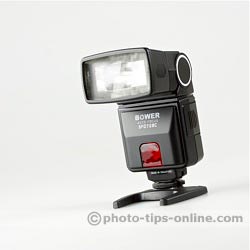 |
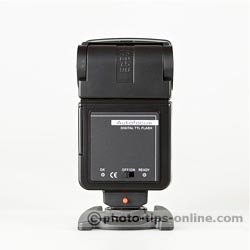 |
Bower SFD728 flash is compact and lightweight (221 grams / 7.8 oz). It is close in size to Nikon Speedlight SB-600 and significantly lighter than flagship flashes, such as Canon Speedlite 580EX II, for example.
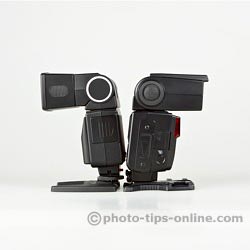 |
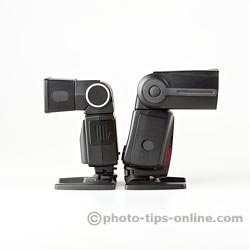 |
The flash head of Bower SFD728 rotates 330 degrees, which is kind of a surprise from a flash of this class. It goes full 180 degrees to the right and 120 degrees to the left. It also tilts from 0 to 90 degrees giving you the plenty of bounce options.
The zoom range of the head is limited to 28, 35, 50, and 85mm positions. The flash head is not motorized, which is one of the things that keep the price low. You have to manually set zoom by pulling the lens on the head. We found it usable, but not very convenient.
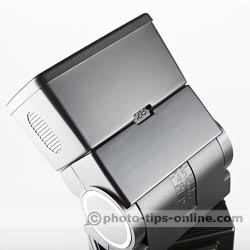 |
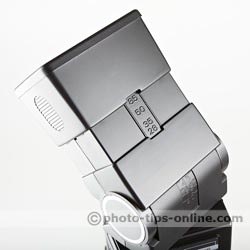 |
Rated at 28m / 92ft (ISO 100@50mm), Bower SFD728 has enough power to be a worthy bounce flash. Our measurement and calculation show that it is about 2/3 of a stop less powerful than Canon Speedlite 430EX II (about 35% less power), but it is still about 2 full stops (4 times) more powerful than a typical built-in pop-up flash of an SLR camera.
The specified recycling time is from 0.5 to 7 seconds. Our tests show that with a set of freshly charged NiMH batteries, Bower SFD728 recycles in about 2-3 seconds after being fired at maximum power.
In a few quick tests that we've done, Bower SFD728 flash also demonstrated a consistent and accurate exposure.
SFD728 offers no controls on its body, and it is fully controlled by the camera. All you have on this flash is a test button and power switch. There are also two indicators: Ready and Auto Check. The second one goes on when a proper exposure is achieved. In cases, when the flash cannot sufficiently illuminate the scene, the Auto Check lamp stays off after the shot is taken.
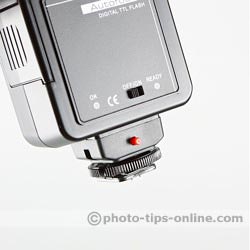 |
Being fully automatic, Bower SFD728 does not offer manual power adjustments. Power output is controlled by TTL function. All you can do is to set flash exposure compensation, but only with a proper camera (see below).
None of the remote operations are possible with this Bower flash, as well, which, at this price point, is no surprise at all. If you want to take SFD728 flash off camera, you need a TTL cord.
While it is not possible to set flash exposure compensation or second curtain synchronization mode on the flash itself, Bower SFD728 supports these features via on-camera menus. If you own one of the later camera bodies that have on-screen flash controls, you can take advantage of these useful functions.
It is worth mentioning that the battery compartment door has a small stopper. So, while it is still possible to fully detach the door, you don't have to do it to replace the batteries, which eliminates the risk of accidently loosing the battery compartment door.
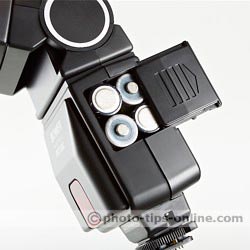 |
Bower SFD728 does not have any locking mechanism to keep the flash head in a certain position. It is rather convenient not needing to push a release button to change the flash head position, but, as a result, the flash head is not capable of supporting relatively heavy accessories. You would want to use either a shoot-through modifier (such as, LumiQuest Softbox or Aurora MINI/MAX Softbox, for example) or a very lightweight bounce card (for instance, Aurora MINI/MAX Bounce Card or Promaster Universal Reflector).
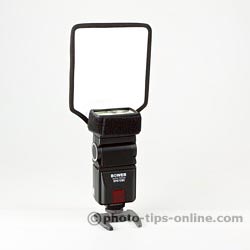 |
Also, please note that SFD728 does not come with a stand or carrying case (the stand you see in the picture is from a Canon flash).
Bower SFD728 digital flash is not aimed to compete with high-end flash guns. You could think of it as an upgrade to your camera's pop-up flash. For a reasonable price, the improvements are:
Also, when used with a modern camera, SFD728 can still do flash exposure compensation and second curtain synchronization (just like your pop-up flash). So, if you don't need all the functions that more expensive flash units offer these days, Bower SFD728 can be a great choice. You will learn how to bounce light and try out a range of light diffusers designed for modern flash guns.